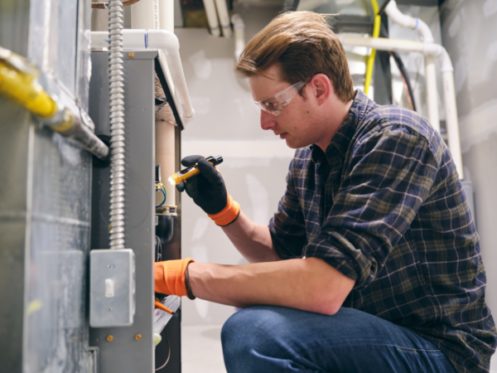Many homeowners rely on a furnace to provide them with heat during the long winter season. While a furnace is a very affordable option for many homeowners, it does come with working parts that can fail from time to time. It can be helpful to understand what your furnace’s ignitor does so that you can identify when it may be having a problem.
What Does a Furnace Ignitor Do?
To create heat in your home, your thermostat will signal to your furnace that it’s time to turn on. When this happens on a gas furnace, the inducer motor kicks on to evaluate the furnace of any lingering gas. Once the pressure sensor checks for back-drafting, it will tell your ignitor that it’s time to fire.
Your ignitor begins to spark or get hot, depending on the specific type of ignitor that you have. Next, the gas valve is opened, and the furnace becomes lit. Once the flame sensor senses a flame, the blower motor will kick on and deliver heat throughout your home. This process happens every time your thermostat signals to your furnace that it needs to provide heat for your home.
Signs of a Faulty Furnace Ignitor
When your furnace ignitor goes bad, there are a few key symptoms that you may notice. First and foremost, your furnace may just not kick on. No matter how high you set your desired temperature, there is simply no response from your furnace. Another sign that your ignitor is bad is when your furnace suddenly shuts off right after it starts.
It’s important to pay close attention to how your furnace is operating when you’re at home. When your ignitor starts to go bad, it may work intermittently. Sometimes you may experience your furnace short-cycling, while other times, it starts up and runs just fine.
As soon as you notice anything out of the ordinary, it’s best to have the problem assessed by an HVAC professional. Doing so can help to get your ignitor replaced before it completely fails and you’re stuck with a furnace that won’t produce heat for your home.
How Will a Professional Assess Your Ignitor?
Whenever you experience a problem with your furnace that you believe is a faulty ignitor, then it’s necessary to call in a professional to fix the issue. Most professionals will utilize the same procedure to diagnose a malfunctioning ignitor.
They’ll start by turning up your thermostat to call for heat and assessing whether or not your inducer motor kicks on. If they don’t see the ignitor working, they’ll use a multimeter to check the resistance. When a multimeter reveals inadequate resistance levels, it becomes clear that your ignitor is indeed faulty.
Top Reasons Why Your Ignitor Went Bad
There are a variety of reasons that could explain why your furnace ignitor went bad. One of the most common reasons is simply an ignitor that is too old. Most furnace ignitors are rated to last for a total of four to seven years. If your ignitor is close to seven years old or older, then it’s a surefire sign that it’s reached the end of its lifespan and needs to be promptly replaced.
Another contributing factor to a faulty furnace ignitor is a short circuit problem. Your furnace ignitor is only rated for 120 volts of power. This is all the power it needs to generate a flame successfully. Whenever a surge of power over 120 volts makes its way to your ignitor, the extra voltage can cause it to short circuit.
How Is a Furnace Ignitor Replaced?
When it comes to replacing your furnace ignitor, it’s best to call in a professional for assistance. After they verify that your furnace’s ignitor is bad, they will proceed to replace it. At first, they will turn off the power to your furnace at its breaker switch.
Next, they’ll open the burner compartment. The ignitor is located deep inside the furnace, right in front of the burners. Most ignitors are simply held in place by screws. Your furnace technician will remove those screws and pull out the bad ignitor.
Being mindful not to touch the ceramic heating element, they will install your new ignitor and screw it down in place. If the ceramic heating element is touched by a human hand, it will have residue oils left behind on its surface. This will cause that specific area of the ignitor to burn extra hot, which will eventually lead to premature failure.
Once the new ignitor is installed, your furnace technician will close up your burner compartment and turn the power back on. They’ll test to ensure that your furnace is now properly igniting.
The 4 Types of Furnace Ignitors
There are four main types of furnace ignitors that can fail. These are standing pilot ignitors, direct spark ignitors, intermittent pilot ignitors, and hot surface ignitors. Telling the difference between the four isn’t too difficult.
1. Standing Pilot Ignitors
Standing pilot ignitors are common on most older furnaces. You’ll see a small flame, known as a pilot light, that always stays lit. This small flame is used to light the gas that comes out of the burners. When your pilot light goes out, you may need to relight it with a match or with a built-in mechanism.
2. Direct Spark Ignitors
Direct spark ignitors use an electrical spark to light your gas burners. You’ll be able to easily see and notice this spark as soon as the gas valve opens.
3. Intermittent Pilot Ignitors
Intermittent pilot ignitors are a little more complex than standing pilot light and direct spark ignitors. This ignitor uses a combination of both. The direct spark that is produced will actually light the pilot flame. Then, the pilot flame will ignite your burners.
4. Hot Surface Ignitors
The most common type of ignitor in most modern furnaces is the hot surface ignitor. This ignitor is constructed of a ceramic piece that warms up to over 2,000 degrees Fahrenheit and is responsible for lighting your gas burners. When your hot surface ignitor is working, you’ll see a bright orange glow, similar to what you would see with an electric stove.
Lifespan of Furnace Ignitors
Furnace ignitors have a lifespan between four and seven years. How long your furnace’s ignitor actually lasts will highly depend on how well your furnace is maintained. If your existing ignitor is over seven years old, it may be time to think about replacing it.
This will prevent you from experiencing a furnace failure during the cold winter season. Since most furnaces have a lifespan of about 20 years, you can expect to replace your ignitor at least twice for every furnace that you have. Some individuals may end up replacing their ignitor more often, especially those who don’t properly care for their furnaces.
Top-Quality Heating Services
Fusion Plumbing & Air offers top-quality heating services for the entire Tucson, AZ area. We also offer professional cooling, plumbing, drain, sewer, and commercial HVAC services. Contact us today to get one of our technicians on the way to your residence or business.




